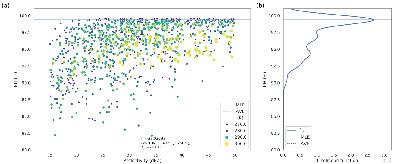当前位置:
X-MOL 学术
›
Q. J. R. Meteorol. Soc.
›
论文详情
Our official English website, www.x-mol.net, welcomes your
feedback! (Note: you will need to create a separate account there.)
One‐dimensional maximum‐likelihood estimation for spaceborne precipitation radar data assimilation
Quarterly Journal of the Royal Meteorological Society ( IF 3.0 ) Pub Date : 2020-12-11 , DOI: 10.1002/qj.3950 Yasutaka Ikuta 1, 2 , Kozo Okamoto 1 , Takuji Kubota 3
Quarterly Journal of the Royal Meteorological Society ( IF 3.0 ) Pub Date : 2020-12-11 , DOI: 10.1002/qj.3950 Yasutaka Ikuta 1, 2 , Kozo Okamoto 1 , Takuji Kubota 3
Affiliation

|
Spaceborne precipitation radar such as Global Precipitation Measurement (GPM)/dual‐frequency precipitation radar (DPR) provides valuable observations of precipitation systems in three dimensions. Assimilation of GPM/DPR data is becoming an important technique for improving the accuracy of forecasting to complement scarce ground‐based observations. This study presents a new, one‐dimensional maximum‐likelihood estimation (1D‐MLE) method developed by the authors that enables the estimation of relative humidity profiles according to a non‐Gaussian probability density function. By assimilating the estimated relative humidity profiles using a four‐dimensional variational (4D‐Var) method, mesoscale precipitation forecasts by the Japan Meteorological Agency (JMA) have been considerably improved. The displacement of forecast precipitation during a severe weather event, in particular, is improved significantly. It was found that forecasting accuracy was maintained for a narrow GPM/DPR swath and low revisit frequency by repeating the assimilation–forecast cycle. Since the effectiveness was confirmed, the JMA began assimilating GPM/DPR data using the 1D‐MLE approach from March 2016.
中文翻译:

星载降水雷达数据同化的一维最大似然估计
诸如全球降水量测量(GPM)/双频降水量雷达(DPR)之类的机载降水量雷达在三个维度上提供了有关降水系统的有价值的观测结果。GPM / DPR数据的同化正成为提高预测准确性以补充稀缺的地面观测资料的重要技术。这项研究提出了一种新的一维最大似然估计(1D-MLE)方法,该方法由作者开发,能够根据非高斯概率密度函数来估计相对湿度曲线。通过使用四度变分(4D-Var)方法吸收估计的相对湿度曲线,日本气象厅(JMA)的中尺度降水预报得到了很大的改善。特别是在严重天气事件期间,预测降水的位移得到了显着改善。结果发现,通过重复同化-预测周期,可以在狭窄的GPM / DPR范围和较低的重访频率下保持预测准确性。自从确认有效性以来,JMA从2016年3月开始使用1D-MLE方法吸收GPM / DPR数据。
更新日期:2020-12-11
中文翻译:

星载降水雷达数据同化的一维最大似然估计
诸如全球降水量测量(GPM)/双频降水量雷达(DPR)之类的机载降水量雷达在三个维度上提供了有关降水系统的有价值的观测结果。GPM / DPR数据的同化正成为提高预测准确性以补充稀缺的地面观测资料的重要技术。这项研究提出了一种新的一维最大似然估计(1D-MLE)方法,该方法由作者开发,能够根据非高斯概率密度函数来估计相对湿度曲线。通过使用四度变分(4D-Var)方法吸收估计的相对湿度曲线,日本气象厅(JMA)的中尺度降水预报得到了很大的改善。特别是在严重天气事件期间,预测降水的位移得到了显着改善。结果发现,通过重复同化-预测周期,可以在狭窄的GPM / DPR范围和较低的重访频率下保持预测准确性。自从确认有效性以来,JMA从2016年3月开始使用1D-MLE方法吸收GPM / DPR数据。











































 京公网安备 11010802027423号
京公网安备 11010802027423号